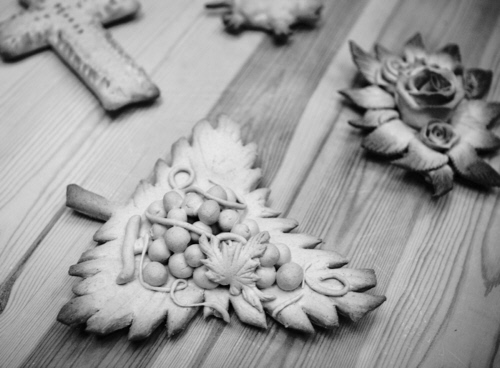After having arrived in Gonnosfanadiga, a so-called town of bread, where bread turns out to be one of the leading products of this village in Medio Campidano, we went to one of the best bakeries in this region, the Porta bakery in order to get to know some of the history of bread connected with the most ancient traditions of the Sardinian culture. The Porta bakery was established in 1918 when Grandma Chiara was always preparing bread for her family and their neighbours. A lot has happened since, but due to lots of work, sacrifice and passion, the Porta confectionery and bakery has become a point of reference in Sardinia for appreciation of the art of bread-making. In 2007, this firm started an educational workshop on bread, giving children, but also adults, the possibility to get to know how to make bread and, at the same time, hold in high regard such a genuine product.
The objective with the educational workshop is to engage all participants in every phase of the preparation of bread: milling Cappelli wheat, sifting, making dough with a sourdough starter and baking.
We were also invited into the workshop of this firm where a wonderful gathering of traditional types of bread in Sardinia like moddizzosu, coccoi and civraxiu together with a small stone mill besides ingredients for making bread like white flour, semolina, Cappelli wheat and a sourdough starter were exhibited on a large table.
Sourdough starters contain yeasts and lactic acid bacteria. While the yeasts expand bread by leaving air pockets after baking, the lactic acid bacteria improve taste, sight, smell and touch of bread as well as their shelf life, nutritional value and wholesomeness. A sourdough starter contains thousands of different microorganisms, which will leaven the bread much slower than when using baker’s yeast.
The sourdough starter has to be renewed regularly and each time it is used for making bread, a part of it is kept for the next bread-making. The microorganisms in the sourdough starter are kept alive by giving them nutrients like semolina for food and water for drinking. It is also necessary to stir it such that the microorganisms can breathe. In fact, the sourdough starter used at Porta dates back at least 70 years, being refreshed from generation to generation.
At the Porta workshop, the students are taught to use all five senses in order to help them recognise a well-made sourdough bread. For instance, it’s possible to recognise a sourdough bread from the sound which arises when it is hit by one’s hand, and the bakers at Porta call it “hear the quality of the bread” because the leavening leaves air pockets inside the bread. A freshly baked bread called moddizosu will emit a sound like a drum when it’s hit by a hand. Looking inside the bread, it can be seen that it is yellowish due to the semolina, a uniform density of holes and a humid, but not pasty texture and a slightly sour aroma. Thus, having “graduated” from the Porta workshop, bakers of all ages can find out if a sourdough bread is made well and in accordance with Sardinian traditions.
This precious food encloses in a certain sense the history of Sardinia.
Riccardo, a master baker at Porta told us: “Each bread in Sardinia was made in accordance with requirements to consumption. For instance, the soft bread which was made in lower Campidano was a bread for peasants because they required a bread which would last a couple of days. Instead, carasau is typical for the region of Nuoro because most of the men were shepherds working outside for long periods, requiring a bread which could last a month or even more. Then, there is the region of Ogliastra where breads were made with potatoes because farmers were cultivating them. There was also the bread of Carloforte, which are really crackers, and called the seaman’s bread because it was used by seamen during long voyages. The crackers were were dipped into water and flavoured with vegetable oil, vinegar, tomatoes and salted tuna. Moreover, there is a bread called spianatina, which is typical for the region of Ozieri”.
This means that every region of Sardinia has its own type of bread connected with the traditions of every place.
It was very interesting for use to rediscover, together with Riccardo, not just the secrets of bread-making, but in particular the symbolism of this food, a food which has become so important for Sardinian culture and traditions, being used in various religious ceremonies, like marriages, baptisms and communions, as a sign of good wishes.
We got to know the history of a bakery, or more correctly, the history of the Porta family through the experience of their ancestors and capabilities obtained over time, commit themselves and getting better and, at the same time, maintaining ancient traditions.
We thank the Porta family for having taught us to appreciate even more the deep roots of a wholesome and genuine food like the Sardinian bread.

